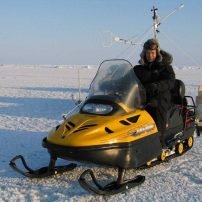
Overview
Twitter: @CAO_EISPAC

Chemical contaminants and plastic debris appear to accumulate in sea ice. In a warmer Arctic the behaviour of these pollutants in single season ice and the timing and extent of exposure for ice-associated biota is unknown but will be investigated.
- Atmosphere or ocean? – where do chemicals and plastics present in sea ice come from and can we measure the exposure to ice-associated organisms?
- Is ice melt critical to the delivery of both nutrients and contaminants to marine surface waters, especially during the Arctic spring when biological activity in the surface ocean increases?
The aim of EISPAC is to assess the importance of ice–associated pollutants and nutrients on ice habitat functioning.
This project is co-funded by the German Federal Ministry of Education and Research and by UKRI NERC.
Dr Crispin Halsall, Lead Investigator of EISPAC:
“Chemical pollutants and plastic debris are present in the Arctic Ocean and can become entrained in sea ice. The changing nature of sea ice, with earlier and erratic periods of thaw, could be altering the processing and release of pollutants alongside key nutrients, which in turn affects biota at the base of the marine foodweb. EISPAC provides a unique opportunity to explore these issues by bringing UK and German researchers together to participate in field and laboratory projects to investigate contaminant and nutrient fate in the sea ice system”
Lead Investigators
-
 View full profile
View full profileProfessor Crispin Halsall
Co-lead investigator, Lancaster University
Crispin Halsall is a Reader in environmental organic chemistry at Lancaster Environment Centre (LEC), Lancaster University. His research expertise is in investigating the environmental fate and impact of synthetic organic chemicals, particularly persistent organic pollutants. Crispin is the co-lead investigator of EISPAC and will investigate the fate of organic pollutants in the sea ice system through both field and laboratory-based studies.
-
 View full profile
View full profileDr Kirstin Dähnke
Co-lead investigator, Helmholtz-Zentrum Geesthacht (HZG)
Kirstin Dähnke is a biologist and Deputy Head of the Department Aquatic Nutrient Cycles at the Institute of Coastal Research. Her research foci are on the nutrient filter in the coastal zone, especially on N transformations in estuaries and marine and coastal sediments. Kirstin Dähnke leads the research in Germany for the EISPAC Project.
Related Articles
-
Synthetic chemicals in sea ice
Jack Garnett and Max Thomas, both postdoctoral researchers in the EISPAC project, have contributed an article to the March edition of \"The Cryosphere and ATmospheric CHemistry\" (CATCH). Read more
25 March 2019 -
UK and Germany combine forces to fund crucial Arctic science
For the first time, the UK and Germany have joined forces to investigate the impact of climate change on the Arctic Ocean. The UK’s Natural Environment Research Council (NERC) and Germany’s Federal Ministry of Education and Research (BMBF) have jointly invested almost £8 million in 12 new projects to carry… Read more
03 July 2018
